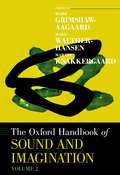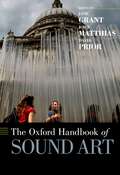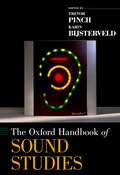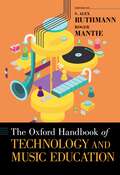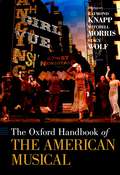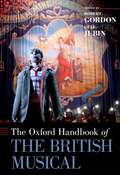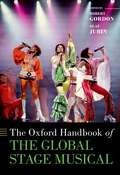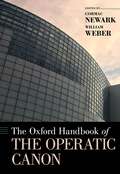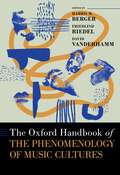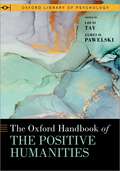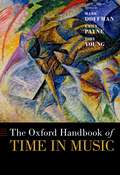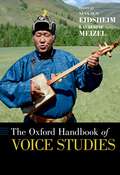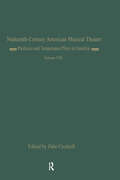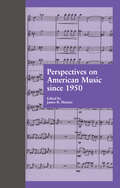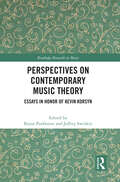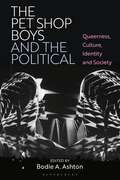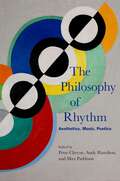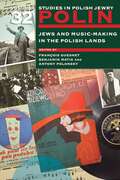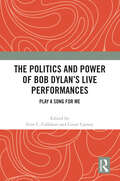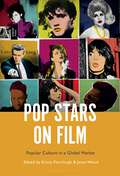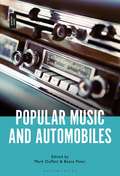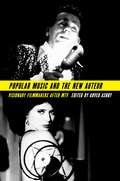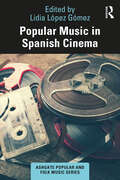- Table View
- List View
The Oxford Handbook of Sound and Imagination, Volume 2 (Oxford Handbooks)
Whether social, cultural, or individual, the act of imagination always derives from a pre-existing context. For example, we can conjure an alien's scream from previously heard wildlife recordings or mentally rehearse a piece of music while waiting for a train. This process is no less true for the role of imagination in sonic events and artifacts. Many existing works on sonic imagination tend to discuss musical imagination through terms like compositional creativity or performance technique. In this two-volume Handbook, contributors shift the focus of imagination away from the visual by addressing the topic of sonic imagination and expanding the field beyond musical compositional creativity and performance technique into other aural arenas where the imagination holds similar power. Topics covered include auditory imagery and the neurology of sonic imagination; aural hallucination and illusion; use of metaphor in the recording studio; the projection of acoustic imagination in architectural design; and the design of sound artifacts for cinema and computer games.
The Oxford Handbook of Sound Art (Oxford Handbooks)
Sound art has long been resistant to its own definition. Emerging from a liminal space between movements of thought and practice in the twentieth century, sound art has often been described in terms of the things that it is understood to have left behind: a space between music, fine art, and performance. The Oxford Handbook of Sound Art surveys the practices, politics, and emerging frameworks of thought that now define this previously amorphous area of study. Throughout the Handbook, artists and thinkers explore the uses of sound in contemporary arts practice. Imbued with global perspectives, chapters are organized in six overarching themes of Space, Time, Things, Fabric, Senses and Relationality. Each theme represents a key area of development in the visual arts and music during the second half of the twentieth century from which sound art emerged. By offering a set of thematic frameworks through which to understand these themes, this Handbook situates constellations of disparate thought and practice into recognized centers of activity.
The Oxford Handbook of Sound Studies (Oxford Handbooks)
Written by the world's leading scholars and researchers in the emerging field of sound studies, The Oxford Handbook of Sound Studies offers new and fully engaging perspectives on the significance of sound in its material and cultural forms. The book considers sounds and music as experienced in such diverse settings as shop floors, laboratories, clinics, design studios, homes, and clubs, across an impressively broad range of historical periods and national and cultural contexts. Science has traditionally been understood as a visual matter, a study which has historically been undertaken with optical technologies such as slides, graphs, and telescopes. This book questions that notion powerfully by showing how listening has contributed to scientific practice. Sounds have always been a part of human experience, shaping and transforming the world in which we live in ways that often go unnoticed. Sounds and music, the authors argue, are embedded in the fabric of everyday life, art, commerce, and politics in ways which impact our perception of the world. Through an extraordinarily diverse set of case studies, authors illustrate how sounds -- from the sounds of industrialization, to the sounds of automobiles, to sounds in underwater music and hip-hop, to the sounds of nanotechnology -- give rise to new forms listening practices. In addition, the book discusses the rise of new public problems such as noise pollution, hearing loss, and the "end" of the amateur musician that stem from the spread and appropriation of new sound- and music-related technologies, analog and digital, in many domains of life. Rich in vivid and detailed examples and compelling case studies, and featuring a companion website of listening samples, this remarkable volume boldly challenges readers to rethink the way they hear and understand the world.
The Oxford Handbook of Technology and Music Education (Oxford Handbooks)
Few aspects of daily existence are untouched by technology. Learning and teaching music are no exceptions and arguably have been impacted as much or more than other areas of life. Digital technologies have come to affect music learning and teaching in profound ways, influencing how we create, listen, share, consume, interact, and conceptualize musical practices and the musical experience. For a discipline as entrenched in tradition as music education, this has brought forth myriad views on what does and should constitute music learning and teaching. To tease out and elucidate some of the salient problems, interests, and issues, The Oxford Handbook of Technology and Music Education critically situates technology in relation to music education from a variety of perspectives: historical; philosophical; socio-cultural; pedagogical; musical; economic; policy, organized around four broad themes: Emergence and Evolution; Locations and Contexts: Social and Cultural Issues; Experiencing, Expressing, Learning and Teaching; and Competence, Credentialing, and Professional Development. Chapters from a highly diverse group of junior and senior scholars provide analyses of technology and music education through intersections of gender, theoretical perspective, geographical distribution, and relationship to the field. The Oxford Handbook of Technology and Music Education's dedication to diversity and forward-facing discussion promotes contrasting perspectives and conversational voices rather than reinforce traditional narratives and prevailing discourses.
The Oxford Handbook of The American Musical (Oxford Handbooks)
The Oxford Handbook of The American Musical offers new and cutting-edge essays on the most important and compelling issues and topics in the growing, interdisciplinary field of musical-theater and film-musical studies. Taking the form of a "keywords" book, it introduces readers to the concepts and terms that define the history of the musical as a genre and that offer ways to reflect on the specific creative choices that shape musicals and their performance on stage and screen. The handbook offers a cross-section of essays written by leading experts in the field, organized within broad conceptual groups, which together capture the breadth, direction, and tone of musicals studies today. Each essay traces the genealogy of the term or issue it addresses, including related issues and controversies, positions and problematizes those issues within larger bodies of scholarship, and provides specific examples drawn from shows and films. Essays both re-examine traditional topics and introduce underexplored areas. Reflecting the concerns of scholars and students alike, the authors emphasize critical and accessible perspectives, and supplement theory with concrete examples that may be accessed through links to the handbook's website. Taking into account issues of composition, performance, and reception, the book's contributors bring a wide range of practical and theoretical perspectives to bear on their considerations of one of America's most lively, enduring artistic traditions. The Oxford Handbook of The American Musical will engage all readers interested in the form, from students to scholars to fans and aficionados, as it analyses the complex relationships among the creators, performers, and audiences who sustain the genre.
The Oxford Handbook of the British Musical (Oxford Handbooks)
The Oxford Handbook of the British Musical provides a comprehensive academic survey of British musical theatre offering both a historical account of the musical's development from 1728 and a range of in-depth critical analyses of the unique forms and features of British musicals, which explore the aesthetic values and sociocultural meanings of a tradition that initially gave rise to the American musical and later challenged its modern pre-eminence. After a consideration of how John Gay's The Beggar's Opera (1728) created a prototype for eighteenth-century ballad opera, the book focuses on the use of song in early nineteenth century theatre, followed by a sociocultural analysis of the comic operas of Gilbert and Sullivan; it then examines Edwardian and interwar musical comedies and revues as well as the impact of Rodgers and Hammerstein on the West End, before analysing the new forms of the postwar British musical from The Boy Friend (1953) to Oliver! (1960). One section of the book examines the contributions of key twentieth century figures including Noel Coward, Ivor Novello, Tim Rice, Andrew Lloyd Webber, director Joan Littlewood and producer Cameron Macintosh, while a number of essays discuss both mainstream and alternative musicals of the 1960s and 1970s and the influence of the pop industry on the creation of concept recordings such as Jesus Christ Superstar (1970) and Les Misérables (1980). There is a consideration of "jukebox" musicals such as Mamma Mia! (1999), while essays on overtly political shows such as Billy Elliot (2005) are complemented by those on experimental musicals like Jerry Springer: the Opera (2003) and London Road (2011) and on the burgeoning of Black and Asian British musicals in both the West End and subsidized venues. The Oxford Handbook of the British Musical demonstrates not only the unique qualities of British musical theatre but also the vitality and variety of British musicals today.
The Oxford Handbook of the Global Stage Musical (Oxford Handbooks)
The stage musical constitutes a major industry not only in the US and the UK, but in many regions of the world. Over the last four decades many countries have developed their own musical theatre industries, not only by importing hit shows from Broadway and London but also by establishing or reviving local traditions of musical theatre. In response to the rapid growth of musical theatre as a global phenomenon, The Oxford Handbook of the Global Stage Musical presents new scholarly approaches to issues arising from these new international markets. The volume examines the stage musical from theoretical and empirical perspectives including concepts of globalization and consumer culture, performance and musicological analysis, historical and cultural studies, media studies, notions of interculturalism and hybridity, gender studies, and international politics. The thirty-three essays investigate major aspects of the global musical, such as the dominance of Western colonialism in its early production and dissemination, racism and sexism--both in representation and in the industry itself--as well as current conflicts between global and local interests in postmodern cultures. Featuring contributors from seventeen countries, the essays offer informed insider perspectives that reflect the diversity of the subject and offer in-depth examinations of specific cultural and economic systems. Together, they conduct penetrating comparative analysis of musical theatre in different contexts as well as a survey of the transcultural spread of musicals.
The Oxford Handbook of the Operatic Canon (Oxford Handbooks)
Opera has always been a vital and complex mixture of commercial and aesthetic concerns, of bourgeois politics and elite privilege. In its long heyday in the eighteenth and nineteenth centuries, it came to occupy a special place not only among the arts but in urban planning, too this is, perhaps surprisingly, often still the case. The Oxford Handbook of the Operatic Canon examines how opera has become the concrete edifice it was never meant to be, by tracing its evolution from a market entirely driven by novelty to one of the most canonic art forms still in existence. Throughout the book, a lively assembly of musicologists, historians, and industry professionals tackle key questions of opera's past, present, and future. Why did its canon evolve so differently from that of concert music? Why do its top ten titles, all more than a century old, now account for nearly a quarter of all performances worldwide? Why is this system of production becoming still more top-heavy, even while the repertory seemingly expands, notably to include early music? Topics range from the seventeenth century to the present day, from Russia to England and continental Europe to the Americas. To reflect the contested nature of many of them, each is addressed in paired chapters. These complement each other in different ways: by treating the same geographical location in different periods, by providing different national or regional perspectives on the same period, or by thinking through similar conceptual issues in contrasting or changing contexts. Posing its questions in fresh, provocative terms, The Oxford Handbook of the Operatic Canon challenges scholarly assumptions in music and cultural history, and reinvigorates the dialogue with an industry that is, despite everything, still growing.
The Oxford Handbook of the Phenomenology of Music Cultures (Oxford Handbooks)
A source of profound insights into human existence and the nature of lived experience, phenomenology is among the most influential intellectual movements of the last hundred years. The Oxford Handbook of the Phenomenology of Music Cultures brings ideas from the phenomenological tradition of Continental European philosophy into conversation with theoretical, ethnographic, and historical work from ethnomusicology, anthropology, sound studies, folklore studies, and allied disciplines to develop new perspectives on musical practices and auditory cultures. With sustained theoretical meditations and evocative ethnography, the book's twenty-two chapters advance scholarship on topics at the heart of the study of music and culture today--from embodiment, atmosphere, and Indigenous ontologies, to music's capacity to reveal new possibilities of the person, the nature of virtuosity, issues in research methods, the role of memory, imagination, and states of consciousness in musical experience, and beyond. Thoroughly up-to-date, the handbook engages with both classical and contemporary phenomenology, as well as theoretical traditions that have drawn from it, such as affect theory or the German-language literature on cultural techniques. Together, these essays make major contributions to fundamental theory in the study of music and culture.
The Oxford Handbook of the Positive Humanities (Oxford Library of Psychology)
This handbook examines the new and rapidly growing field of the positive humanities--an area of academic research at the intersection of positive psychology and the arts and humanities. Written by leading experts across a wide range of academic disciplines, the volume begins with an overview of the science and culture of human flourishing, covering historical and current trends in this literature. Next, contributors consider the well-being benefits of engagement with the arts and humanities, marking out neurological, cognitive, emotional, behavioral, and social pathways to human flourishing. These pathways lead to detailed investigations of individual fields within the arts and humanities, including music, the visual arts, philosophy, history, literature, religion, theater, and film. Along the way, the book thoroughly synthesizes theory, research, and exemplary practice, concluding with thought-provoking discussions of avenues for public engagement and policy. With its expansive coverage of both the field as a whole and specialized disciplinary and interdisciplinary drivers, The Oxford Handbook of the Positive Humanities advances the literature on the theory and science of well-being and extends the scope of the arts and humanities.
The Oxford Handbook of Time in Music (Oxford Handbooks)
Music represents one of humanity's most vivid contemplations on the nature of time itself. The ways that music can modify, intensify, and even dismantle our understanding of time's passing is at the foundation of musical experience, and is common to listeners, composers, and performers alike. The Oxford Handbook of Time in Music provides a range of compelling new scholarship that examines the making of musical time, its effects and structures. Bringing together philosophical, psychological, and socio-cultural understandings of time in music, the chapters highlight the act of 'making' not just as cultural construction but also in terms of the perceptual, cognitive underpinnings that allow us to 'make' sense of time in music. Thus, the Handbook is a unique synthesis of divergent perspectives on the nature of time in music. With its focus on contemporary music (while paying attention to some of the generative temporalities of the nineteenth century), the volume establishes the richness and complexity of so much current music-making and in the process overcomes historic demarcations between art and popular musics.
The Oxford Handbook of Voice Studies (Oxford Handbooks)
More than 200 years after the first speaking machine, we are accustomed to voices that speak from any- and everywhere. We interact daily with voices that emit from house alarm systems, cars, telephones, and digital assistants, such as Alexa and Google Home. However, vocal events still have the capacity to raise age-old questions about the human, the animal, the machine, and the spiritual-or in non-metaphysical terms-questions about identity and authenticity. In The Oxford Handbook of Voice Studies, contributors look to the metaphorical voice as well as the clinical understanding of the vocal apparatus to answer the seemingly innocuous question: What is voice? From a range of disciplines including the humanities, biology, culture, and technology studies, contributors draw on the unique methodologies and values each has at hand to address the uses, meanings, practices, theories, methods, and sounds of the voice. Together, they assess the ways that discipline-specific, ontological, and epistemological assumptions of voice need to shift in order to take the findings of other fields into account. This Handbook thus enables a lively discussion as multifaceted and complex as the voice itself has proven to be.
Pasticcio and Temperance Plays in America: Il Pesceballo (1862) and Ten Nights Volume 8 (Nineteenth-Century American Musical Theater Series)
The series aims to represent all the major genres and styles of musical theater of the century, from ballad opera through melodrama, plays with incidental music, parlor entertainments, pastiche, temperance shows, ethnic theater, minstrelsy, and operetta, to grand opera. This series of sixteen volumes provides for the first time ever a comprehensive set of works from a full century of musical theater in the United States of America. The two works in this volume seemingly have little in common. They reflect the society in which they were created in quite different ways. Il Pesceballo is an intelligent and subtle parody of operatic conventions, closer to the tradition of literary burlesque. Ten Nights in a Bar-Room is a play with interpolated song, a theatrical vehicle for moral evangelizing. The first, by America’s first great ballad scholar, remained practically unknown and unperformed; the second, by a forgotten actor/playwright, became legendary and widely embedded in the American cultural heritage. Yet both share at least two important features. One is their incorporation of easily recognized music. The works are also related through the purposes for which they were completed and performed.
Perspectives on American Music since 1950 (Essays in American Music)
As the century comes to a close, composition of music in the United States has reached little consensus in terms of style, techniques, or schools. In fourteen original articles, the contributors to this volume explore the broad range and diversity of post-World War II musical culture. Classical and jazz idioms are both covered, as is the broad history of electronic music in the United States.
Perspectives on Contemporary Music Theory: Essays in Honor of Kevin Korsyn (Routledge Research in Music)
Kevin Korsyn is a renowned music theorist, musicologist, and pedagogue who has taught at the University of Michigan since 1992. He has published widely and influentially in areas as diverse as Beethoven and Brahms studies, chromatic tonality, disciplinarity and metatheory, history of theory, musical meaning and hermeneutics, poststructuralism (deconstruction, intertextuality, etc.), and Schenkerian theory and analysis. Because of the scope and caliber of his published work, and also his legacy as a pedagogue, Korsyn has had a profound impact on the field of music theory, along with the related fields of historical musicology and aesthetics. This book, a festschrift for Korsyn, comprises essays that constellate around his numerous scholarly foci. Represented in the volume are not only familiar music-theoretical topics such as chromaticism, form, Schenker, and text-music relations, but also various interdisciplinary topics such as deconstruction, disability studies, German Idealism, posthumanism, and psychoanalysis. The book thus reflects the increasingly multifaceted intellectual landscape of contemporary music theory.
The Pet Shop Boys and the Political: Queerness, Culture, Identity and Society
The Pet Shop Boys came of age at a time of deep socio-political tension. From the rise of sexual politics and awareness to Thatcherite neoliberalism and the Cold War, this book explores the cultural and political impact of the band and offers a fascinating window into the late 20th and early 21st centuries. An archetypal 'gay band', it shows how their overt queerness influenced generations of LGBTQIA+ music lovers and artists alike. Covering the full oeuvre of The Pet Shop boys; their albums, films, stage productions and collaborations, chapters in this collection show how their work is suffused with political commentary on the past and present covering themes as broad as queer identity, the HIV/AIDs epidemic, globalization and Brexit. It also places them within the context of their times and considers them as activists, authors, social commentators, political actors and personalities to better understand what influenced them. Bringing together a range of perspectives and disciplines, The Pet Shop Boys and the Political provides a unique and untapped insight into a formative pop band of the modern era that has mirrored and shaped society over the past forty years.
The Philosophy of Rhythm: Aesthetics, Music, Poetics
Rhythm is the fundamental pulse that animates poetry, music, and dance across all cultures. And yet the recent explosion of scholarly interest across disciplines in the aural dimensions of aesthetic experience--particularly in sociology, cultural and media theory, and literary studies--has yet to explore this fundamental category. This book furthers the discussion of rhythm beyond the discrete conceptual domains and technical vocabularies of musicology and prosody. With original essays by philosophers, psychologists, musicians, literary theorists, and ethno-musicologists, The Philosophy of Rhythm opens up wider-and plural-perspectives, examining formal affinities between the historically interconnected fields of music, dance, and poetry, while addressing key concepts such as embodiment, movement, pulse, and performance. Volume editors Peter Cheyne, Andy Hamilton, and Max Paddison bring together a range of key questions: What is the distinction between rhythm and pulse? What is the relationship between everyday embodied experience, and the specific experience of music, dance, and poetry? Can aesthetics offer an understanding of rhythm that helps inform our responses to visual and other arts, as well as music, dance, and poetry? And, what is the relation between psychological conceptions of entrainment, and the humane concept of rhythm and meter? Overall, The Philosophy of Rhythm appeals across disciplinary boundaries, providing a unique overview of a neglected aspect of aesthetic experience.
Plan of an Orchestra layout (UEB Contracted)
This is a labelled plan (seen from above) of a classical orchestra, showing where the various instrumentalists and the conductor are placed on the concert platform. There is a locator dot shown, which will be at the top left of the page when the image is the right way up. The conductor is in the bottom centre of the page; he is the performer who is nearest the audience and stands with his back to them, facing the rest of the players further up the page. The various areas occupied by the instruments are labelled. The stringed instruments occupy the bottom third of the page with the woodwind and brass instruments further up the page. The percussion instruments are at the top left of the page.
Plan of an Orchestra layout (UEB Uncontracted)
This is a labelled plan (seen from above) of a classical orchestra, showing where the various instrumentalists and the conductor are placed on the concert platform. There is a locator dot shown, which will be at the top left of the page when the image is the right way up. The conductor is in the bottom centre of the page; he is the performer who is nearest the audience and stands with his back to them, facing the rest of the players further up the page. The various areas occupied by the instruments are labelled. The stringed instruments occupy the bottom third of the page with the woodwind and brass instruments further up the page. The percussion instruments are at the top left of the page.
Polin: Jews and Music-Making in the Polish Lands (Polin: Studies in Polish Jewry #32)
With its five thematic sections covering genres from cantorial to classical to klezmer, this pioneering multi-disciplinary volume presents rich coverage of the work of musicians of Jewish origin in the Polish lands. It opens with the musical consequences of developments in Jewish religious practice: the spread of hasidism in the eighteenth century meant that popular melodies replaced traditional cantorial music, while the greater acculturation of Jews in the nineteenth century brought with it synagogue choirs. Jewish involvement in popular culture included performances for the wider public, Yiddish songs and the Yiddish theatre, and contributions of many different sorts---technical and commercial as well as creative---in the interwar years. Chapters on the classical music scene cover Jewish musical institutions, organizations, and education; individual composers and musicians; and a consideration of music and Jewish national identity. One section is devoted to the Holocaust as reflected in Jewish music, and the final section deals with the afterlife of Jewish musical creativity in Poland, particularly the resurgence of interest in klezmer music. The essays in this collection do not attempt to to define what may well be undefinable---what ‘Jewish music’ is. Rather, they provide an original and much-needed exploration of the activities and creativity of ‘musicians of the Jewish faith’.CONTRIBUTORS: Eliyana R. Adler, Michael Aylward, Sławomir Dobrzański, Paula Eisenstein-Baker, Beth Holmgren, Sylwia Jakubczyk-Ślęczka, Daniel Katz, James Loeffler, Michael Lukin, Filip Mazurczak, Bożena Muszkalska, Julia Riegel, Ronald Robboy, Robert Rothstein, Joel E. Rubin, Adam J. Sacks, Amanda (Miryem-Khaye) Seigel, Eleanor Shapiro, Carla Shapreau, Tamara Sztyma, Bella Szwarcman-Czarnota, Joseph Toltz, Maja Trochimczyk, Magdalena Waligórska, Bret Werb, Akiva Zimmerman
The Politics and Power of Bob Dylan’s Live Performances: Play a Song for Me
Ephemeral by nature, the concert setlist is a rich, if underexplored, text for scholarly research. How an artist curates a show is a significant aspect of any concert’s appeal. Through the placement of songs, variations in order, or the omission of material, Bob Dylan’s setlists form a meta-narrative speaking to the power and significance of his music. These essays use the setlists from concerts throughout Dylan’s career to study his approach to his material from the 1960s to the 2020s. These chapters, from various disciplinary perspectives, illustrate how the concert setlist can be used as a source to explore many aspects of Dylan’s public life. Finally, this collection provides a new method to examine other musicians across genres with an interdisciplinary approach to setlists and the selectivity of performance. Unique in its approach and wide-ranging scholarly methodology, this book deepens our understanding of Bob Dylan, the performer.
Pop Stars on Film: Popular Culture in a Global Market
Pop stars have provided audiences with performative moments that have become ingrained in popular consciousness. They are a lens through which deeper understandings about race, gender, politics, history and the artistic process can be understood. When combined with the most affective of mediums – cinema, the combination can be both thrilling and alarming.From the relatively early days of cinema, figures from the world of popular music have made forays into acting and contributed cameo appearances. From Little Richard and Kylie Minogue to Nick Cave and Tom Waits, Pop Stars On Film: Popular Culture in a Global Market offers a collection of essays on some of the most influential international performances from a diverse range of cultural icons. The book considers industry shifts, access and diversity, but also the notion of cultural appropriation, audience appeal, marketing and demographics. Perhaps most importantly, the publication will look at what happens when cultures collide and coalesce.
Popular Music and Automobiles
Particularly since the 1950s, cars and popular music have been constantly associated. As complementary goods and intertwined technologies, their relationship has become part of a widely shared experience-one that connects individuals and society, private worlds and public spheres. Popular Music and Automobiles aims to unpack that relationship in more detail. It explores the ways in which cars and car journeys have shaped society, as well as how we have shaped them. Including both broad synergies and specific case studies, Popular Music and Automobiles explores how attention to an ongoing relationship can reveal insights about the assertion and negotiation of identity. Using methods of enquiry that are as diverse as the topics they tackle, its contributors closely consider specific genders, genres, places and texts.
Popular Music and the New Auteur: Visionary Filmmakers after MTV
MTV utterly changed the movies. Since music television arrived some 30 years ago, music videos have introduced filmmakers to a new creative vocabulary: speeds of events changed, and performance and mood came to dominate over traditional narrative storytelling. Popular Music and the New Auteur charts the impact of music videos on seven visionary directors: Martin Scorsese, Sofia Coppola, David Lynch, Wong Kar-Wai, the Coen brothers, Quentin Tarantino, and Wes Anderson. These filmmakers demonstrate a fresh kind of cinematic musicality by writing against pop songs rather than against script, and allowing popular music a determining role in narrative, imagery, and style. Featuring important new theoretical work by some of the most provocative writers in the area today, Popular Music and the New Auteur will be required reading for all who study film music and sound. It will be particularly relevant for readers in popular music studies, and its intervention in the ongoing debate on auteurism will make it necessary reading in film studies.
Popular Music in Spanish Cinema (Ashgate Popular and Folk Music Series)
Popular Music in Spanish Cinema analyses the aesthetics and stylistic development of soundtracks from national productions, considering how political instability and cultural diversity in Spain determined the ways of making art and managing culture. As a pioneering study in this field, the chronologically structured approach of this book provides readers with a complete overview of Spanish music and connects it to the complex historical events that conditioned Spanish culture throughout the 20th century to the present day, from the Second Republic, the Spanish Civil war, and the dictatorship through to democracy. The book enables an understanding of the relationships between the recording and film production industries, the construction of collective imagination, the formulation of new stereotypes, semiotic meanings within film music and the musical exchanges between national and international cinema. This volume is an essential read for students and academics in the field of musicology, ethnomusicology and history as well as those interested in the study of diverse musical styles such as copla, zarzuela, flamenco, jazz, foxtrot, pop and rock and how they have been used in Spanish films throughout history.
